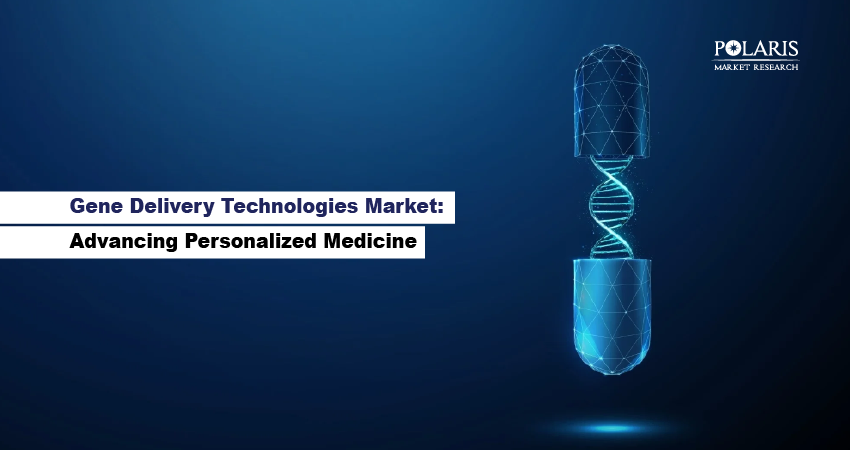Gene Delivery Technologies Market: Advancing Personalized Medicine

There have been profound advances in genetic science over the years. Today, it has become possible to treat diseases at their molecular roots. Central to this change are gene delivery technologies, which allow for precise transport of genetic material into the target cells.
Effective delivery of genes is important for gene therapy and regenerative medicine. This blog post explains to you the essentials of gene delivery technologies. It also details the key stats and factors driving the gene delivery technologies market forward.
Understanding Gene Delivery
Gene delivery refers to the introduction of nucleic acids into cells to have a therapeutic effect. The nucleic acids can take the form of DNA, RNA, or oligonucleotides. Gene delivery isn’t limited to the transfer of genetic material. It’s a highly controlled process by which the efficacy and duration of gene expression are determined. Gene delivery aims at ensuring that the therapeutic gene makes its way to the right cells.
Successful delivery of genes needs to overcome various biological barriers. These include degradation by enzymes and immune clearance. Then there’s the challenge of inefficient cellular uptake. As such, both viral and non-viral systems have been developed to suit different applications.
Key Market Metrics
We’ve done an in-depth assessment of the rapidly evolving gene delivery technologies market. Our analysis reveals the market for these technologies stood at USD 5.42 billion in 2024. It is expected to account for a CAGR of 11.1% between 2025 and 2034.
The prevalence of genetic disorders and chronic conditions has been on the rise across the globe. This has led to increased demand for advanced gene delivery technologies. The gene delivery technologies market is also benefiting from the rising incidence of genetic disorders worldwide.
Types of Gene Delivery Systems
Viral Delivery Systems
Viral delivery systems rely on the inherent ability of viruses to enter host cells and deliver genetic material in an efficient way. Genetic engineering removes pathogenic elements and changes viruses into safe and highly effective carriers. Adenoviruses (AdV) are among the most widely used viral vectors. The high transduction efficiency of AdV makes it suitable for the development of vaccines and certain gene therapies. Adeno-associated viruses (AAV) are known for their strong safety profile and can target specific tissues.
Lentiviruses are derived from retroviruses. They are uniquely capable of integrating therapeutic genes into the host genome. This allows for stable and continuous expression even in non-dividing cells. Viral systems also have their own set of challenges, including limited genetic cargo capacity and immune system activation.
Non-Viral Delivery Systems
Non-viral delivery systems make use of physical, chemical, or mechanical methods. The transportation of the genetic material doesn’t have viral involvement. Non-viral delivery systems allow for improved safety profiles and accuracy in design. Commonly used non-viral methods include lipid-based carriers, polymeric vectors, and physical methods. Lipid-based carriers involve the use of liposomes and lipid nanoparticles. These particles encapsulate nucleic acids and protect them from degradation. That way, targeted delivery is facilitated.
The polymeric vectors method involves the use of synthetic polymers such as polyethyleneimine and poly(lactic-co-glycolic acid). These synthetic polymers bind to nucleic acids and facilitate endocytosis. They make controlled release possible. Other physical methods, such as electroporation and microinjection, physically introduce genes into cells through electrical fields or pressure.
Applications of Gene Delivery Technologies
Gene Therapy
Gene delivery is a highly important aspect of the gene therapy market. It allows for the correction and replacement of genes causing the disease. The use of adeno-associated viruses (AAV) and lentiviruses allows scientists to directly introduce functional genetic material into patient cells for restoring normal function. This approach has proven highly beneficial for hemophilia and inherited retinal diseases, where traditional treatments may not be effective. The precision of targeted drug delivery ensures long-term benefits and minimizes systemic side effects.
DNA and RNA Vaccines
Gene delivery technologies are also used in the realm of genetic vaccines. Here, these technologies transport DNA or RNA sequences that instruct the body to produce specific antigens. This, in turn, triggers an immune response. mRNA vaccines for COVID-19, made possible by lipid nanoparticle (LNP) technology, have shown how powerful and scalable the approach is. The technology is making its way beyond infectious diseases. It is now being used in cancer immunotherapy. Here, personalized vaccines train the immune system to recognize and attack tumor-specific proteins.
Cancer Treatment
The use of gene delivery technologies in oncology is changing cancer therapy. These technologies have made highly selective and minimally invasive treatments possible. Techniques involving the use of oncolytic viruses and plasmid DNA make it possible to directly target tumor cells. Systems from the cancer gene therapy market are capable of delivering genes that trigger apoptosis in malignant cells. Additionally, they suppress oncogenes that result in uncontrolled proliferation. Furthermore, the combination of gene delivery with immune checkpoint inhibitors is allowing for the development of next-generation cancer treatments.
AI and Gene Delivery Technologies Market
Artificial intelligence (AI) is being used during various stages of gene delivery development. The capability of AI to analyze large datasets makes it possible to predict and generate novel delivery vehicles. AI is used in non-viral systems for the optimization of lipid nanoparticles and polymer formulation parameters. That way, lipid compositions and particle sizes can be selected to maximize cellular uptake. AI also enables “smart manufacturing” of gene delivery systems by monitoring production lines and optimizing process controls.
Conclusion
Gene delivery technologies are changing medicine. These technologies have enabled researchers to turn genetic discoveries into real treatments. They have made it possible to target diseases at their source: genes. With growing emphasis on making processes safer and more efficient, the path to routine genetic therapies is becoming increasingly clear. In the coming years, the gene delivery technologies market is expected to witness increased collaborations among research institutes, hospitals, and biotechnology firms.

